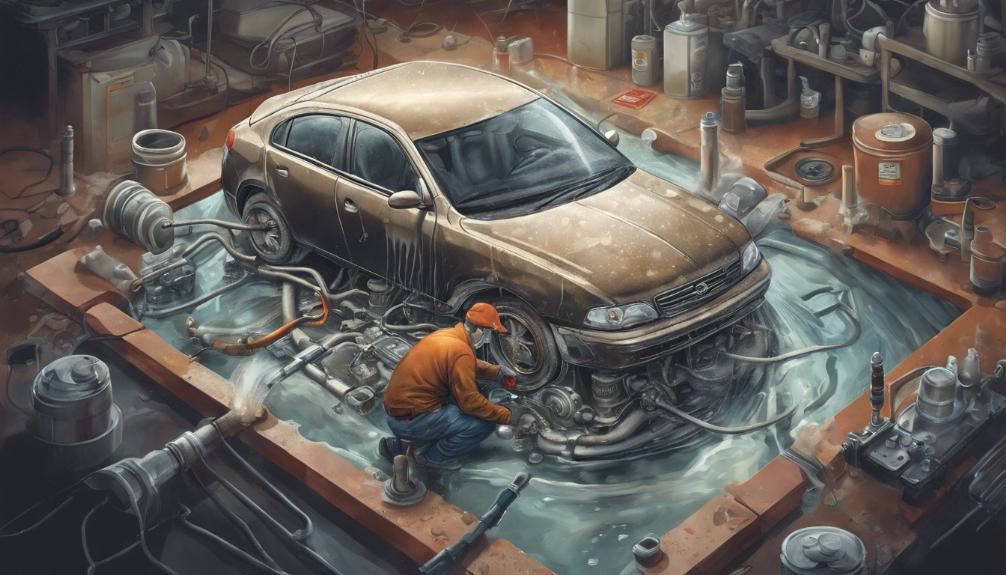If you find reddish or brownish fluid beneath your vehicle, notice odd shifting, or smell burning near the transmission, these could signal a transmission seal leak. This issue, if ignored, may cause severe transmission harm.
Such leaks often occur due to worn seals, degraded seal material, improper installation, or aging wear and tear. Low fluid levels from leaks can lead to poor lubrication, overheating, and contamination damaging critical parts.
Timely professional repairs are essential. Address symptoms promptly, seek correct repairs, and prioritize routine maintenance to prevent future leaks.
Taking action early can save you from costly transmission repairs.
What You Need to Know
- Look for reddish or brownish fluid leaks under the vehicle.
- Notice unusual shifting behavior like slipping gears.
- Check for low transmission fluid levels leading to poor lubrication.
- Be cautious of burning smell from the transmission area.
- Consider age, wear, and driving conditions as factors in seal degradation.
Symptoms of Transmission Seal Leak
If you notice visible fluid leaks under your vehicle, especially with a reddish or brownish color, these could be signs of a transmission seal leak.
Transmission seal leaks can lead to fluid contamination and result in low transmission fluid levels, causing poor lubrication that may damage the transmission system.
The deterioration of seals can allow transmission fluid to escape, affecting the proper functioning of your vehicle.
Symptoms of transmission seal leaks also include unusual shifting behavior, such as slipping gears or delayed engagement.
Furthermore, a burning smell emanating from the transmission area could indicate transmission fluid leaking due to damaged seals.
Recognizing these signs early on is vital as addressing transmission seal leaks promptly can prevent further damage to the transmission system.
Regularly checking for fluid leaks under your vehicle and being vigilant about any color changes can help you detect transmission seal leaks early.
Taking action swiftly can save you from costly repairs and safeguard the smooth operation of your transmission.
Common Causes of Seal Leak
Common causes of seal leaks in a transmission system often stem from worn or damaged transmission seals that fail to effectively contain fluid.
The seal material plays an important role in preventing leaks; over time, seals can degrade due to exposure to high temperatures, pressure, and friction.
These harsh conditions can cause the seals to harden, crack, or lose their flexibility, leading to fluid leakage.
Improper installation of seals during maintenance or repair work is another significant cause of leaks. If seals aren’t correctly fitted, they may not provide a secure barrier against fluid escape.
Furthermore, age-related wear and tear on seals can make them more prone to leakage.
Driving in harsh conditions, exposure to debris or contaminants, and lack of regular maintenance can all accelerate seal deterioration and result in leaks.
Regularly monitoring seal condition and addressing any issues promptly can help prevent transmission fluid leaks and maintain the system’s efficiency.
Impact of Seal Leak on Transmission
The outcomes of a transmission seal leak can greatly affect the performance and longevity of your vehicle’s transmission system. When a seal leak occurs, it can lead to deteriorating performance and lubrication issues within the transmission.
Here are some key impacts to be aware of:
- Low Fluid Levels: A seal leak can cause low fluid levels in the transmission, resulting in poor lubrication and increased friction between moving parts.
- Overheating: Insufficient cooling from the fluid due to a leak can lead to the transmission overheating, potentially causing damage to internal components.
- Contaminant Entry: Seal leaks may allow contaminants to enter the transmission, accelerating wear on critical parts and leading to potential damage.
- Costly Repairs: Ignoring a seal leak can result in costly repairs or even transmission failure over time, emphasizing the importance of addressing the issue promptly through professional repairs.
Addressing Seal Leak Promptly
To promptly address a seal leak in your vehicle’s transmission, it’s important to take immediate action to prevent further damage.
Ignoring the issue can lead to transmission fluid loss and potential harm to the transmission system.
Once you notice symptoms like puddles of transmission fluid under the vehicle or difficulty shifting gears, it’s important to address the seal leak promptly.
There are repair options available to fix the seal leak, such as replacing the worn or damaged seals causing the issue. Seeking professional help for this repair can guarantee that it’s done correctly and effectively.
Also, regular inspection and maintenance are essential to identifying and addressing seal leaks early on before they escalate into more serious transmission problems.
Preventing Future Seal Leaks

To prevent future seal leaks in your vehicle’s transmission, establishing a proactive maintenance routine is crucial. Here are some maintenance tips to help you prolong the longevity of your transmission seals:
- Regularly inspect and replace worn transmission seals to prevent leaks.
- Guarantee proper installation of seals during routine maintenance for best performance.
- Address any leaks promptly to avoid transmission damage and costly repairs.
- Use high-quality seals and follow manufacturer recommendations to enhance seal longevity.
As an Amazon Associate we earn from qualifying purchases.










